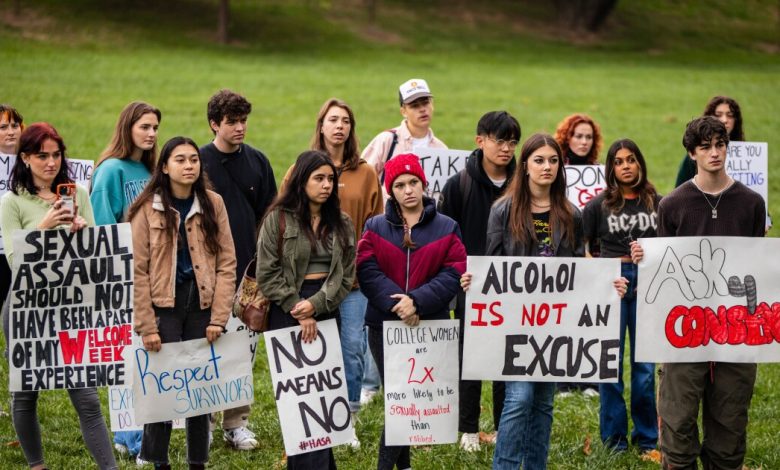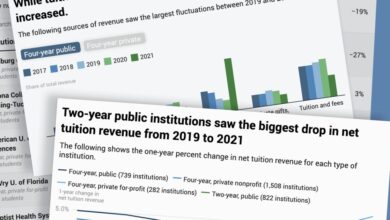Why Aren’t Men Involved in Sexual-Assault Prevention? A New Report Offers Insights

[ad_1]
Colleges have spent decades trying to figure out how to involve male students in sexual-assault prevention, with limited success. But sexual misconduct remains a gendered experience, experts say, and reaching men is the only way to meaningfully reduce its prevalence.
New research from It’s On Us, an organization to prevent sexual assault on campus, aims to highlight gaps in the training that colleges provide, and offers recommendations for improvement. The qualitative study adds to a growing body of research and best practices on how to engage men in preventing sexual misconduct.
Colleges are required by federal law to provide programming on sexual-assault prevention to their students and employees. But experts say that institutions must go beyond one brief session that isn’t tailored to a specific group. A central goal of engaging men in prevention is to reduce the burden on women, who are most often the victims of sexual violence, to protect themselves.
For the new It’s On Us study, researchers conducted in-depth interviews with 20 male-identifying students from a range of racial and ethnic backgrounds. Half of the students attended public colleges, and half attended private ones. Seven were members of fraternities.
Here are some of the key findings.
Men don’t know the extent of sexual assault on campus.
Many of the men interviewed were unaware of how pervasive sexual violence is on campus or why it should matter to them. According to the Rape, Abuse, and Incest National Network, or RAINN, more than a quarter of women and about 7 percent of men experience sexual assault in college.
Several students thought the issue didn’t affect them or their institution. Some thought sexual violence was a bigger issue at larger colleges with Greek-letter organizations, where fraternities and alcohol-fueled parties dominate the social scene. “And so if you are at a school without Greek life, it was sort of assumed that you didn’t have a problem with sexual violence on your campus,” Tracey Vitchers, executive director of It’s On Us, said in an interview.
While research has shown that fraternity membership is correlated with a greater risk of such misconduct, sexual assault is a problem at all colleges. The new report urges colleges to convey that message more clearly.
“That’s going to require some institutional courage,” Vitchers said. “Really being honest and transparent with students like, ‘Yes, sexual assault is a problem on college campuses, and it’s not something that’s a problem at some faraway school. It’s a problem at our institution.’”
Men want to get involved in sexual-assault prevention, but don’t feel as if they have the tools to intervene.
The men surveyed expressed interest in learning how to de-escalate and intervene in situations related to sexual violence. But most students felt they hadn’t received the right training. Many reported tuning out of mandatory training either because they thought they didn’t need it or because the training wasn’t interesting.
“A lot of men were saying how all of these online programs are talking about bystander intervention,” Vitchers said. “But because the examples that they are being provided with don’t actually feel reflective of experiences or environments on their campus, it doesn’t actually provide them with an understanding of how to intervene in a situation.”
Creative training increases engagement.
The men spoke ill of online training, saying it was boring and ineffective. Said one Northwestern University student: “Every two years, the [university] has us do these online modules … They just recycle the same stuff, and it’s online, and you just half-ass it because you want to get it over with, and it seems like it’s common sense to just not assault someone.”
Students reported positive experiences with in-person, interactive training, and said getting a certification for completing training had made them feel more involved.
“One of the things that young men noted,” Vitchers said, “was that even at campuses where they offered in-person prevention education and training, since the pandemic, the schools have veered very hard in the direction of only providing online training.”
Female friends: a positive influence on men.
The men who were most aware of the problem of sexual violence on campus had strong female friendships. And male students were more likely to intervene as an active bystander if they had a family member or friend who had survived sexual violence, or had close female friends.
Men who played on sports teams that practiced with women were more likely to have friendships “across the gender spectrum,” Vitchers said, meaning they better understood the issues affecting women on campus.
“Men on campus need more nonmale friends and role models,” Vitchers said. “The men who were more likely to exist in more single-sex environments … were more likely to be in environments that incubated toxic masculinity, misogynistic views, etc., towards nonmale peers and were less in tune with the idea that sexual assault was actually a problem on their campus.”
What’s next?
It’s On Us now plans to conduct a large-scale quantitative survey on engaging men in prevention.
Across higher ed, researchers and campus practitioners have been testing different models, hoping to target male athletes, fraternity members, and other groups of men with education that actually speaks to them. One approach, for instance, involved an 11-week curriculum, with participants spending two hours each week learning about sexual violence, gender socialization, and sexuality. The intervention decreased students’ sexism, acceptance of rape myths, and gender-biased language.
Still, many experts stress that men need to be talking about consent and bystander intervention well before they get to college, when their attitudes and behaviors are still forming.
[ad_2]
Source link






